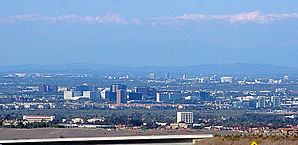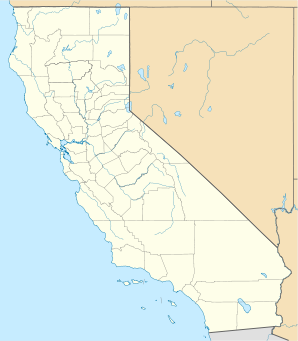Irvine (California)
| Irvine | ||
|---|---|---|
 Downtown |
||
| Location in California | ||
|
|
||
| Basic data | ||
| Foundation : | 1971 | |
| State : | United States | |
| State : | California | |
| County : | Orange County | |
| Coordinates : | 33 ° 41 ′ N , 117 ° 48 ′ W | |
| Time zone : | Pacific ( UTC − 8 / −7 ) | |
| Residents : | 242,651 (as of 2013) | |
| Population density : | 1,350.3 inhabitants per km 2 | |
| Area : | 180.5 km 2 (approx. 70 mi 2 ) of which 179.7 km 2 (approx. 69 mi 2 ) are land |
|
| Height : | 17 m | |
| Postcodes : | 92602-92604, 92606, 92612, 92614, 92616-92620, 92623, 92697, 92709, 92710 | |
| Area code : | +1 714, 949 | |
| FIPS : | 06-36770 | |
| GNIS ID : | 1660804 | |
| Website : | www.ci.irvine.ca.us | |
| Mayor : | Steven Choi ( R ) | |
Irvine is a university town in California's Orange County ( USA ). It was planned and built in the 1960s by a private company, the Irvine Company .
Today there are more than 260,000 residents in Irvine. The rapidly growing, affluent city is known outside of the United States for its high schools and universities. According to the FBI, it is considered the safest big city in the United States because it has the lowest crime rate .
geography
Irvine is 60 kilometers southeast of Los Angeles . The distance to the Pacific coast is less than ten kilometers. To the northeast of the city is Irvine Lake .
history
The Gabrieleño Indian people inhabited the area 2000 years ago. The Spanish explorer Gaspar de Portolà reached the region in 1769, which led to the establishment of forts, missions and the creation of cattle herds. The King of Spain, later the Viceroy of Mexico, gave land to missions and as private property.
Three Mexican concessions formed the property that later became the Irvine Ranch: Rancho Santiago de Santa Ana, Rancho San Joaquin, and Rancho Lomas de Santiago. In 1864, California was now part of the United States, Jose Andres Sepulveda, the owner of Rancho San Joaquin, sold 50,000 acres (200 km²) to Benjamin and Thomas Flint, Llewellyn Bixby and James Irvine for $ 18,000 . He wanted to settle his debts due to a dry spell. Irvine later bought the others' shares; therefore the train station in the area was later named after him and his ranch.
When Los Angeles expanded southward in the early 1960s, the owners of the Irvine Ranch sold their land to the Irvine Company, which was tasked with planning an entire city, including a university. The city map of Irvine was designed by the Los Angeles architect William Pereira . The construction time was almost ten years; In 1971 city rights were officially granted. The place then grew rapidly.
In 2005 Irvine had a population of more than 180,000 for the first time. Since Irvine's population and economic growth continues to this day, new districts are already being planned. On July 1, 2015, there were 256,927 residents in the city (estimate). At the 2010 Census there were still 212,375 inhabitants.
City structure
All districts of Irvine were meticulously planned by the Irvine Company in order to “create a beautiful, peaceful and well-functioning city” according to their own statements.
Irvine is made up of the following districts, some of which are under construction or in the planning stage (bold).
|
|
Demographics
According to the 2000 census, 143,072 people lived here in 51,199 households and 34,354 families. The population density was 1196 per km ². 53,711 residential units were recorded. The racial the population was composed of 61.06% White, 1.45% African American, 0.19% Native American, 29.83% Asian, 1.14% Pacific Islander, and 2.54% other ethnic groups; 4.82% said they came from several ethnic groups. 7.37% of the population were Hispanic or Latino of any race.
Of the 51,199 households, 36.0% had children or adolescents living with them. 53.8% were married couples living together, 9.8% were a single mother, and 32.9% were non-families. 22.8% were made up of single households and 5.0% had people aged 65 years or over. The average household size was 2.70 and the average family size 3.17.
The population was distributed among 23.5% under 18 years of age, 14.4% from 18 to 24 years of age, 32.3% from 25 to 44 years of age, 22.6% from 45 to 64 years of age and 7.2% from 65 years of age or older. The mean age ( median ) was 33 years. For every 100 females there were 93.8 males and for every 100 females age 18 or over there were 90.0 males.
The median income for a household (median) was 98 923 US $ , and the median income for a family 111,455 $. Males had a median income of $ 64,189 and females $ 41,810. The per capita income was $ 32,196. 5.0% of families and 9.1% of the population lived below the poverty line, including 6.1% of the population under the age of 18 and 5.6% of the population aged 65 or over.
education
Irvine is home to the University of California, Irvine , Alliant International University , Concordia University Irvine and Irvine Valley College campuses .
economy
Irvine is home to many IT companies that have settled here since the mid-1990s. These are often even located directly on the university campus.
Among others, the following companies are based in Irvine:
|
The headquarters of the sports car manufacturer Saleen and the development studio for computer role-playing games Troika Games were also located in Irvine.
Town twinning
There are city partnerships with the following cities:
-
 Tsukuba , Japan , since 1989
Tsukuba , Japan , since 1989 -
 Hermosillo , Mexico , since 1990
Hermosillo , Mexico , since 1990 -
 Taoyuan , Republic of China (Taiwan) , since 2000
Taoyuan , Republic of China (Taiwan) , since 2000 -
 Seocho-gu ( Seoul Municipality ), South Korea , since 2013
Seocho-gu ( Seoul Municipality ), South Korea , since 2013
A city friendship exists with
-
 Nowon-gu ( Seoul Municipality ), South Korea , since 2008
Nowon-gu ( Seoul Municipality ), South Korea , since 2008
sons and daughters of the town
- Carson Branstine (* 2000), tennis player
- Tim Commerford (* 1968), rock bassist
- Austin Daye (born 1988), basketball player
- Will Ferrell (born 1967), actor
- Angela Kang (* 1976), television producer, screenwriter and showrunner
- Dustin Kensrue (* 1980), singer, songwriter and guitarist
- Ezra Klein (* 1984), political columnist
- Nam Le (born 1980), poker player
- Catherine Leduc (* 1993), tennis player
- Jason Lezak (* 1975), swimmer
- Peter López (* 1981), Peruvian taekwondo athlete
- Annie Mumolo (* 1973), screenwriter, voice actress and actress
- Amber Neben (* 1975), racing cyclist
- Nicole Parker (* 1978), actress and musical artist
- Aaron Peirsol (* 1983), swimmer
- Krystal Steal (* 1982), porn actress
The post-hardcore band Thrice was formed in Irvine in 1998.
Individual evidence
- ↑ Samuel Stebbins, Evan Comen: Safe cities: California, Texas are home to many of towns with lower violent crime rates , USA Today , October 27, 2019 (data status of the report: 2018); accessed March 30, 2020.
- ↑ United States Census Bureau - Irvine, California
- ↑ Irvine city, California , data sheet with the results of the 2000 census at factfinder.census.gov .
- ^ Website Irvine - Sister Cities Program
- ^ Website Irvine - Friendship Cities Program

